Disclosure: Meeple Mountain received a free copy of this product in exchange for an honest, unbiased review. This review is not intended to be an endorsement.
Have you ever daydreamed about being slick and cool enough to pull off your own Ocean’s 11-style heist? Casually displaying your special expertise and cool demeanor as you outmaneuver lasers, hack computer systems, and outwit the ever-present, roaming guards?
Well, Burgle Bros. might just be the game for you.
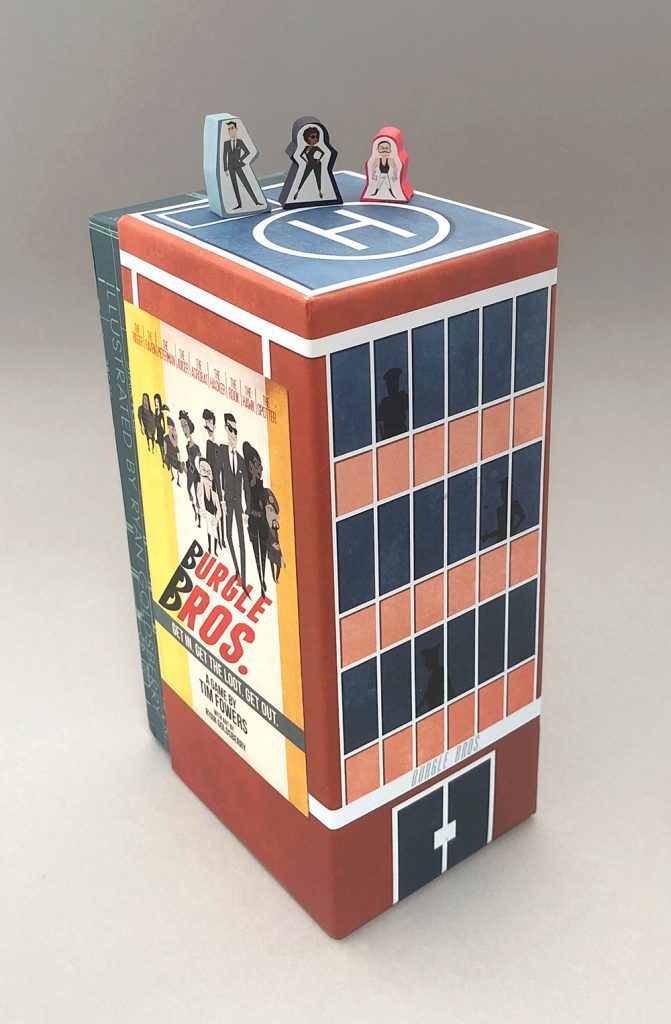
Crack the Safe and Make a Run for It!
As an elite group of professionals, you know what you need to do: get in, grab the loot, and get out! Burgle Bros. is a cooperative game where you’ll be working together to search the rooms on each floor, find the Safe, crack the combination, then make a dash to the stairs leading you to the next floor — or, if you’re on the top floor, to the Helipad where a chopper is waiting to fly you away to victory!
Setting Up the Game
There are a surprising amount of bits and pieces to this game given the size of the box (more on that later). Let’s take a look at them one at a time.
Choose Your Character
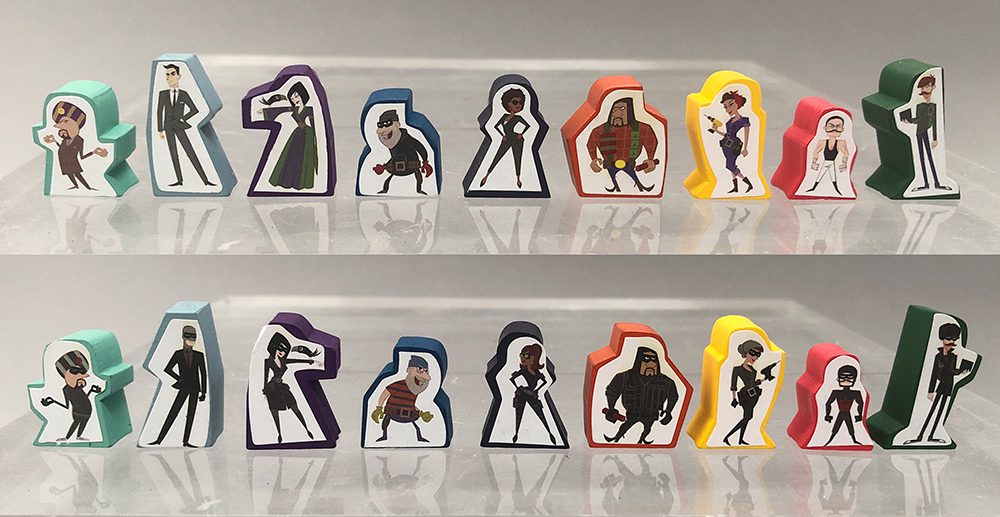
True to the movie trope, each character has their own special skill that makes them a valuable member of the team. As well, each character has an advanced version that has a different skill set that can be played after you’re more familiar with the game.
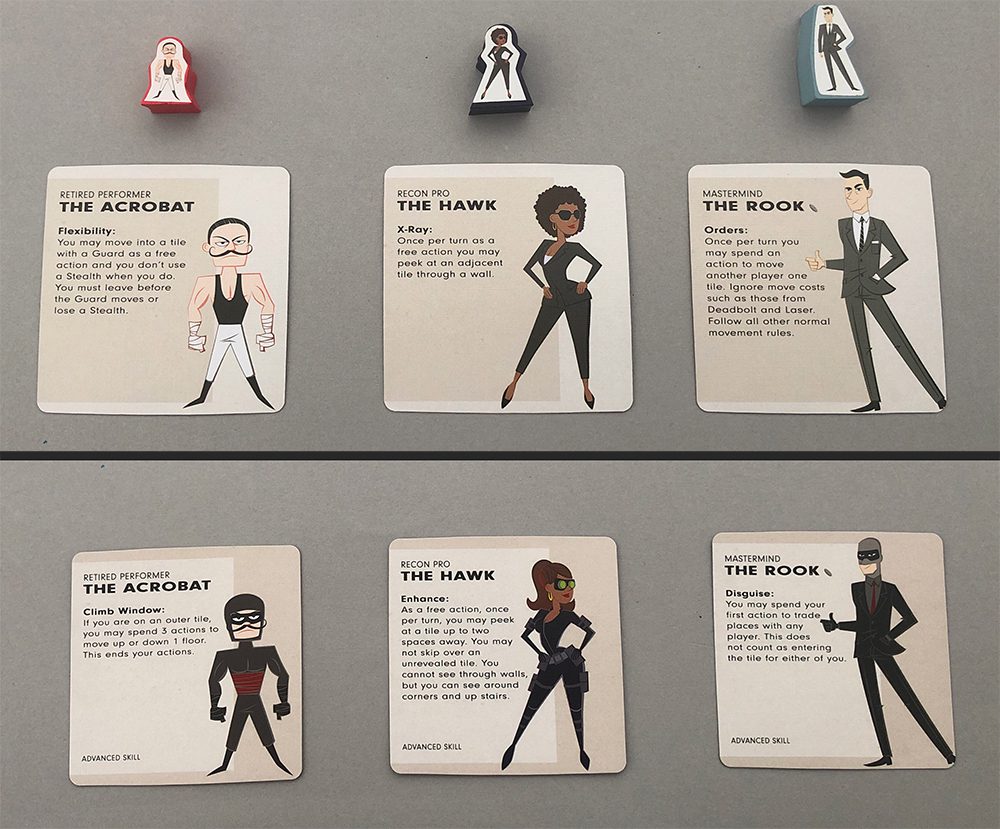
The rule book says you should choose characters at random, but we’ve always chosen our own characters. Our goal has been to win with all of the different characters in both their basic and advanced abilities and it’s made for a fun challenge.
Separate All of the Chits
There are a lot of chits in Burgle Bros. that you’ll need to separate into piles. They’ll make more sense in context, so I’ll discuss them over the course of the review.

For the moment, give three Stealth tokens to each player and place them on their character cards.
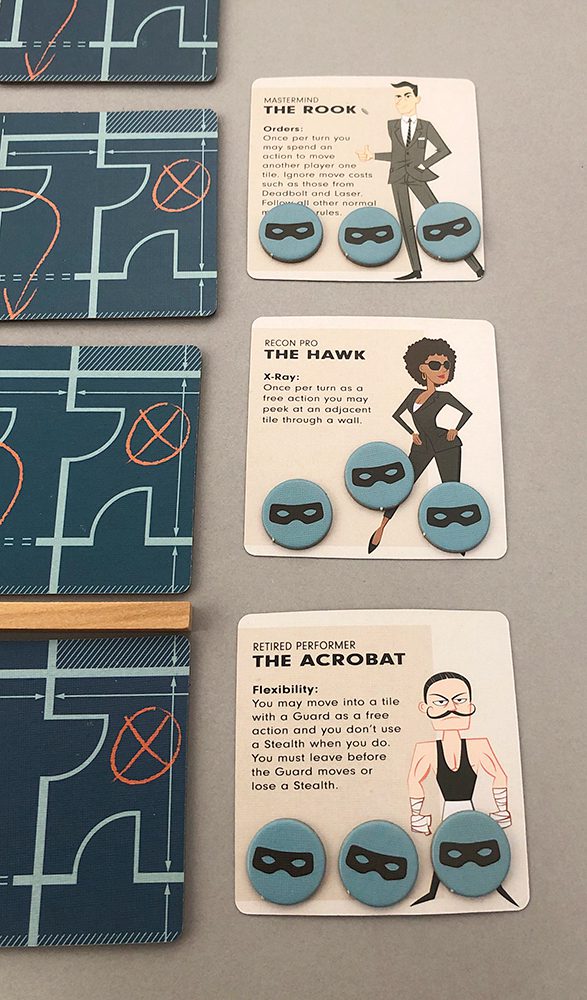
More on Stealth in a moment. First, let’s set up the tiles for the floors of the building we’re going to be breaking into.
Separate the Tiles
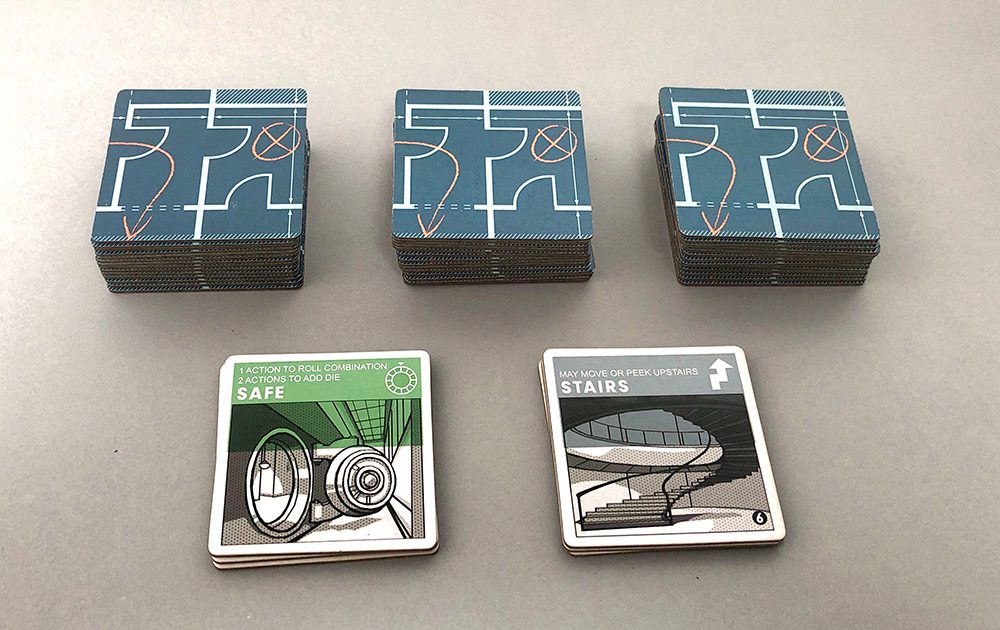
For the standard game, The Bank Job, start by pulling out the three Safe tiles and the three Stairs tiles. Then randomly divide the remaining tiles into three piles. Add a Safe and a Stairs tile to each pile and shuffle well.
Build the Floors
For The Bank Job, lay out a stack of 16 tiles in a 4×4 grid and place wooden dividers into place as I have in the photo below:
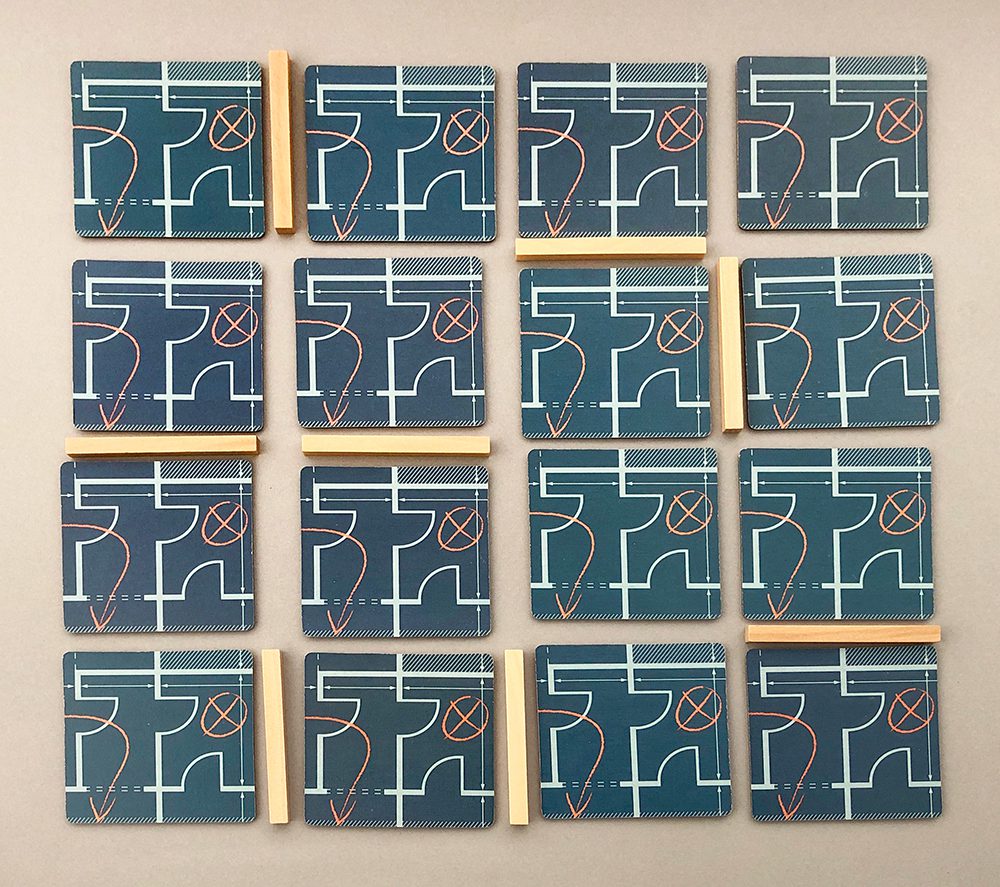
Characters can travel from room to room (tile to tile) through any open passageway. The wooden markers indicate walls that cannot be passed through, neither by you or the Guards.
Speaking of the Guards…
Call Out the Guards!

You didn’t think you and your crew were going to just waltz into the bank, take all the treasure, and leave without any chance of being caught now, did you? Of course not.
Set the three Guards out, one for each floor of The Bank Job.
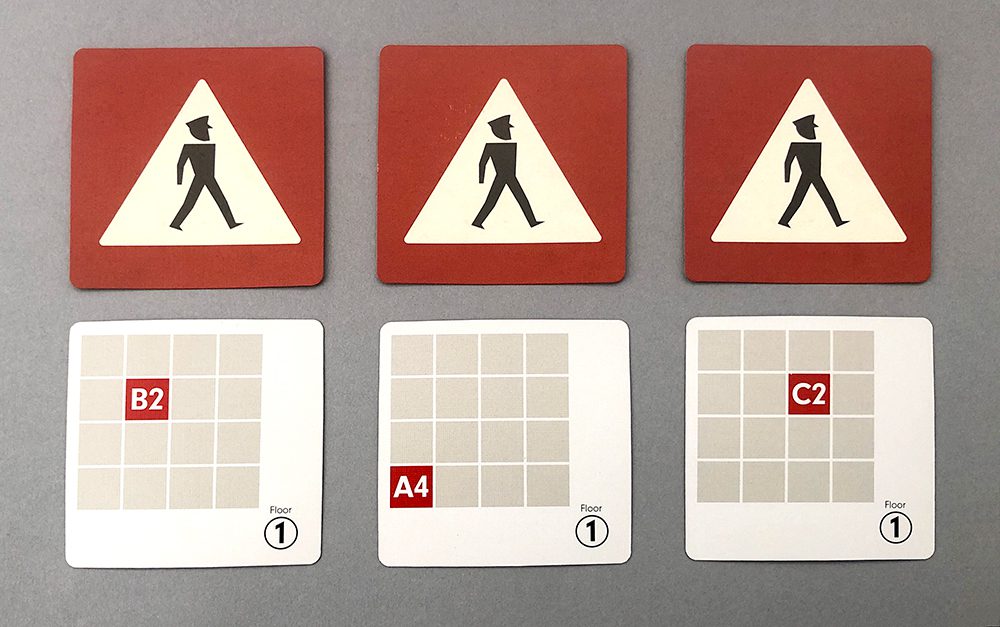
Set the Guard deck for the first floor off to the side. These cards will show you where the Guard is moving to on their next turn.
The Guard starts off moving one step per floor plus one for each floor’s level. (Two steps on the first floor, three steps on the second floor, etc.) To keep track of any changes to the Guard’s movement ability, place an orange die above the deck with the Guard’s current movement value face up.
The Guard moves after each player takes a turn on their floor. This means Guards move a lot.
If a Guard walks into the Room (tile) where your character is standing, they may hide from the Guard — but it costs your character one Stealth token. If your character loses all three Stealth tokens they must avoid the Guard at all costs. If the Guard steps into the Room they’re in or in any way spots them, the Guard immediately captures your character and you all lose the game.
But I’m getting ahead of myself! Let’s go back to the start of the game.
Starting the Game
After the tiles are laid out the first Guard card is turned over.
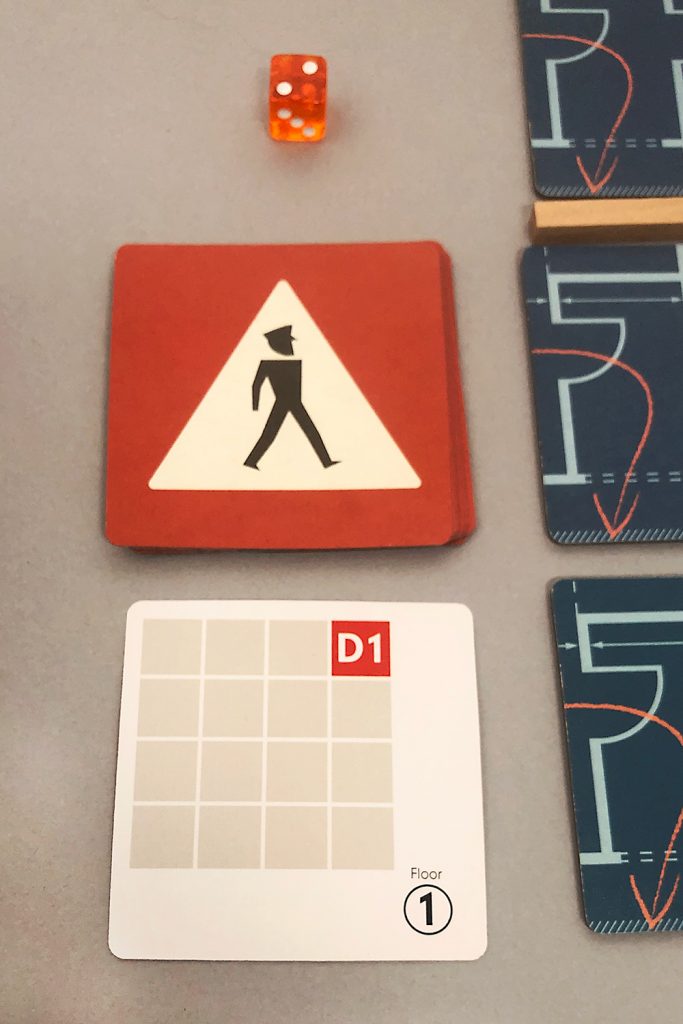
The Guard for that floor is placed on the location indicated.
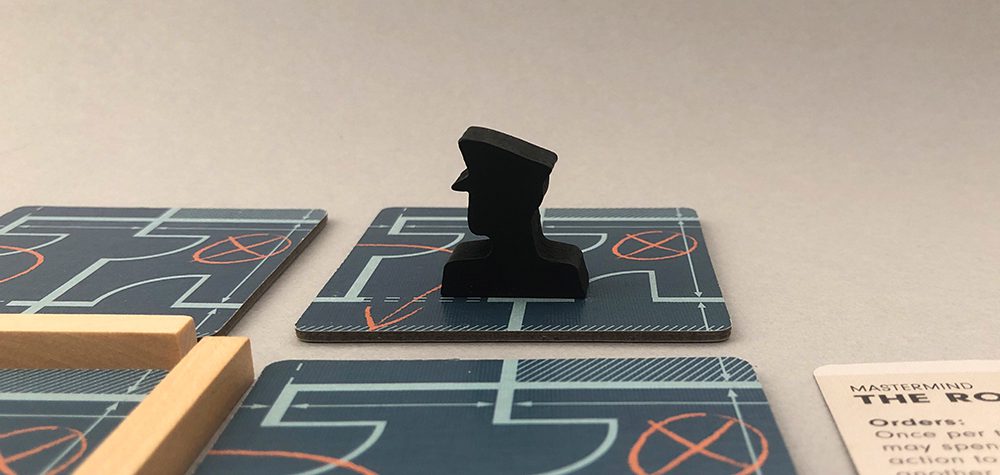
With that information, the players then decide which tile they want to use as their entry point into the building.
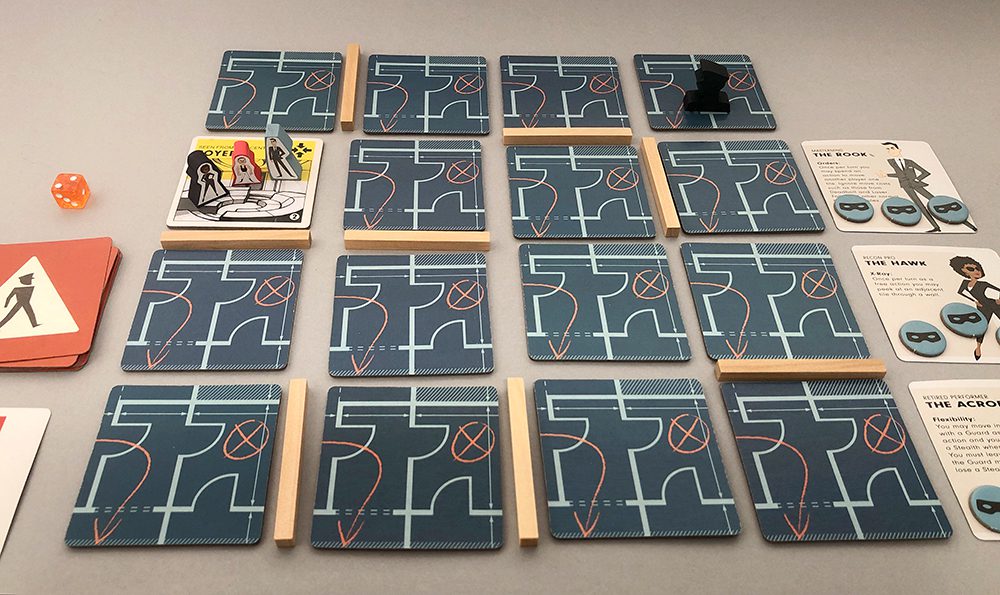
In this case, the players chose to start on a nearby tile. They turn the tile face up and place their characters on the tile.
If that entry point tile has an immediate effect, that effect is not triggered. (Alarms do not go off, etc.) However, if players return to that tile during the course of the game, the tile’s effect is activated.
Playing the Game
Now that the game is set up, you’re ready to break into the building and start searching for the Safes and the Stairs, while avoiding the Guards and getting caught. Here’s how you and your crew will do that.
Moving the Characters
Players are concerned with three things. The first two involve finding the Safe and finding the Stairs up to the next floor; the third is avoiding the Guards, which I will detail shortly. On a player’s turn they can take up to four actions. Those actions include:
- Peeking into a room orthogonally next to the tile you’re on, provided it is not separated by a wall. When Peeking, the tile is turned face up.
- Move onto a tile orthogonally adjacent to the tile you’re on.
Moving onto a face up tile is safe in that you already know what’s in that room. However, if the Guard is coming up on you, you may have to dash dangerously into a room and hope for the best.
That, however, is a very risky proposition. Why? Take a look at the types of Rooms shown on the face up side of the tiles.

You can choose to end your turn despite having actions still available to use. If you end a turn with two or more actions remaining you must draw an Event card.
Occasionally, Event cards are helpful. Most of the time, though, they are not.
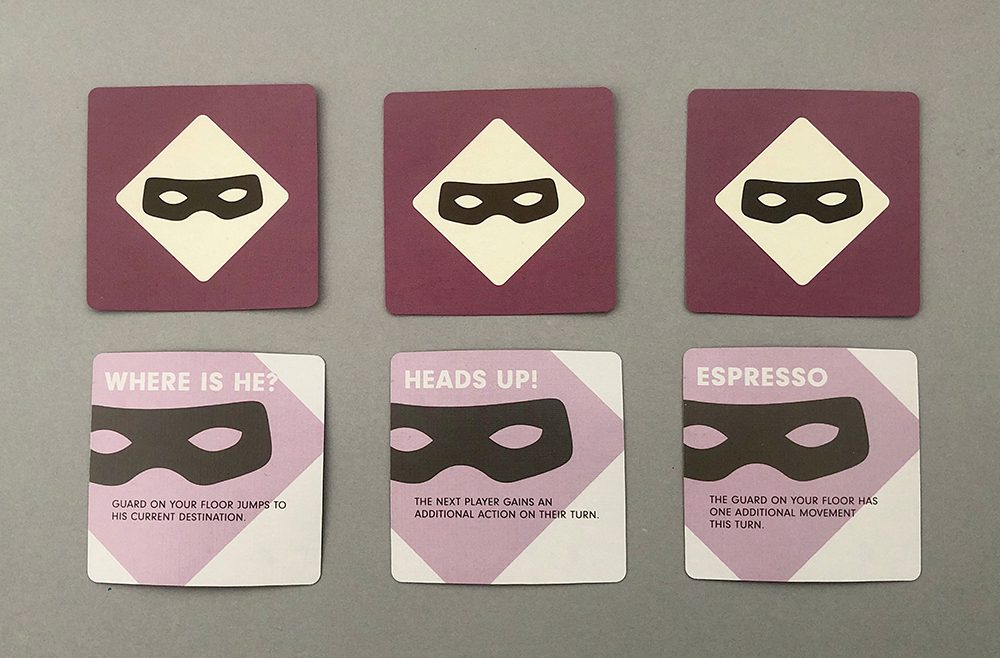
Moving the Guard
The third thing players are concerned with is avoiding the Guards.
As mentioned previously, at the end of each player’s turn the Guard is moved. On the first floor, the Guard starts by moving only two rooms per turn. As the Guard does so, those tiles remain face down. (Only characters turn tiles over either by Peeking or Entering without Peeking — i.e. Moving Dangerously.)
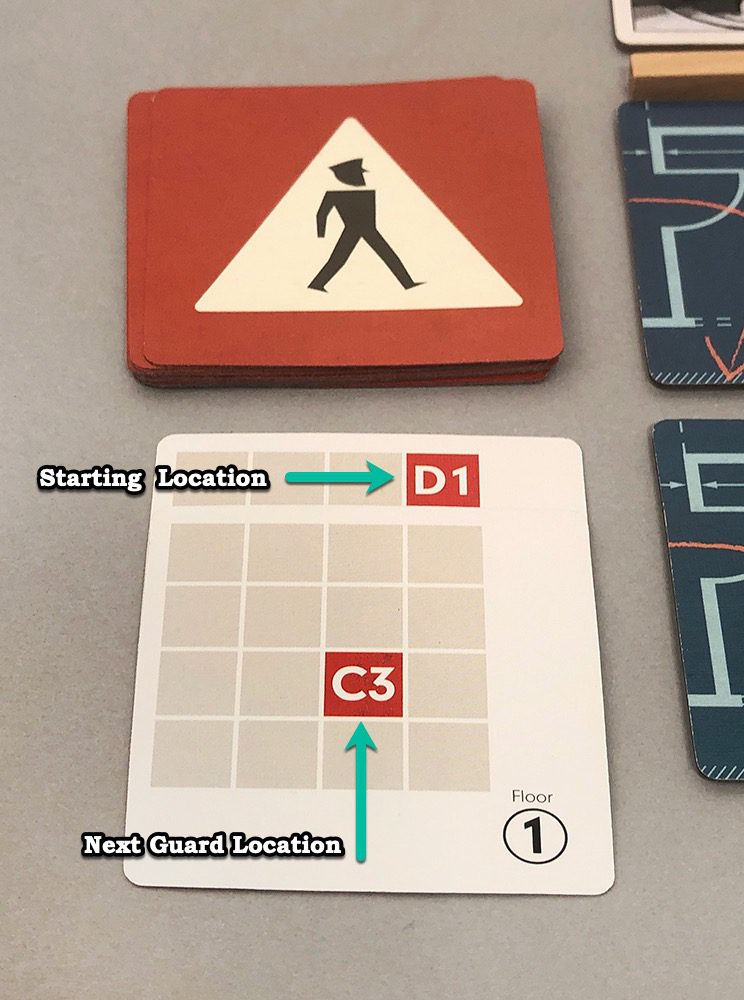
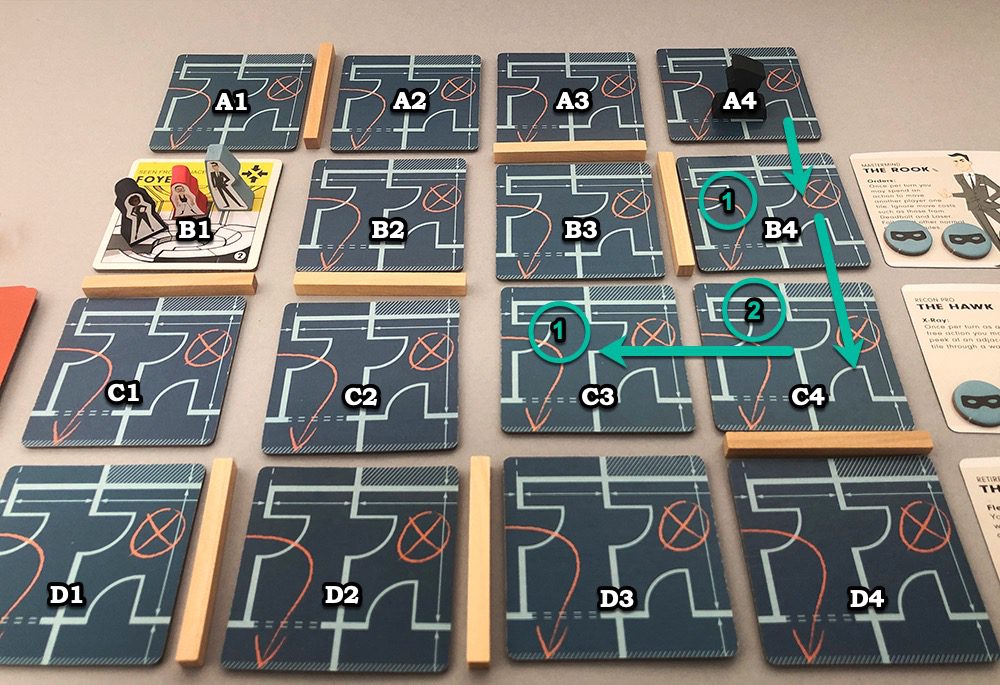
The Guard always moves clockwise through the tiles and takes the most direct route to their next destination. Once there, the next Guard card is turned face up. If a Guard still has movements left after reaching that destination, they continue moving toward their next destination.
If players activate an alarm, an Alarm token is placed on the tile where the alarm went off. The Guard then moves to investigate the alarm, adding an additional movement to the Guard die until reaching the alarm. If players set off multiple alarms the Guard goes to the closest alarm first.
Of course, Guards move freely through all of the Detector, Laser, Fingerprint, Deadbolt, and Keypad tiles — all of the rooms that slow the players down. After all, they have the proper security clearance to access each of these rooms.
The Safe
Your group of elite thieves are working to steal the treasures kept in the three Safes of The Bank Job — one Safe per floor. You’ll need to investigate all of the rooms until you find the Safe hidden amongst the tiles.
Each Safe has a secret combination that needs to be cracked before you can help yourself to the valuables inside. That combination will require two things:
- All of the numbers to the combination
- Dice to roll to match the numbers of the combination
Let’s look at each one.
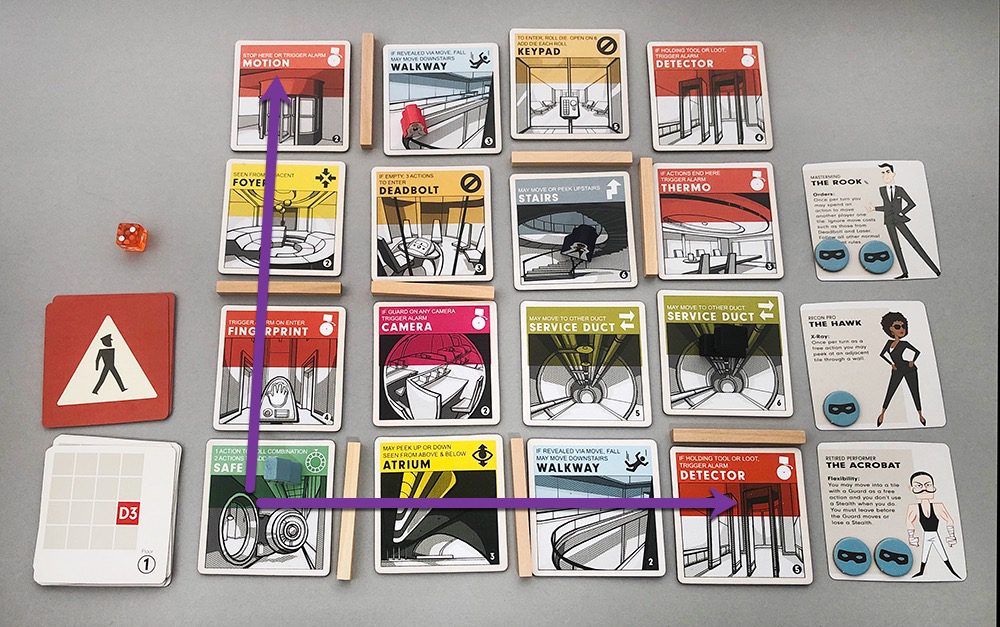
Once the Safe has been discovered the combination can then be deciphered. By tracing two lines from the Safe — up and down, right and left — you’ll be able to collect the numbers necessary to crack the safe.

Each combination will be made up of six numbers.
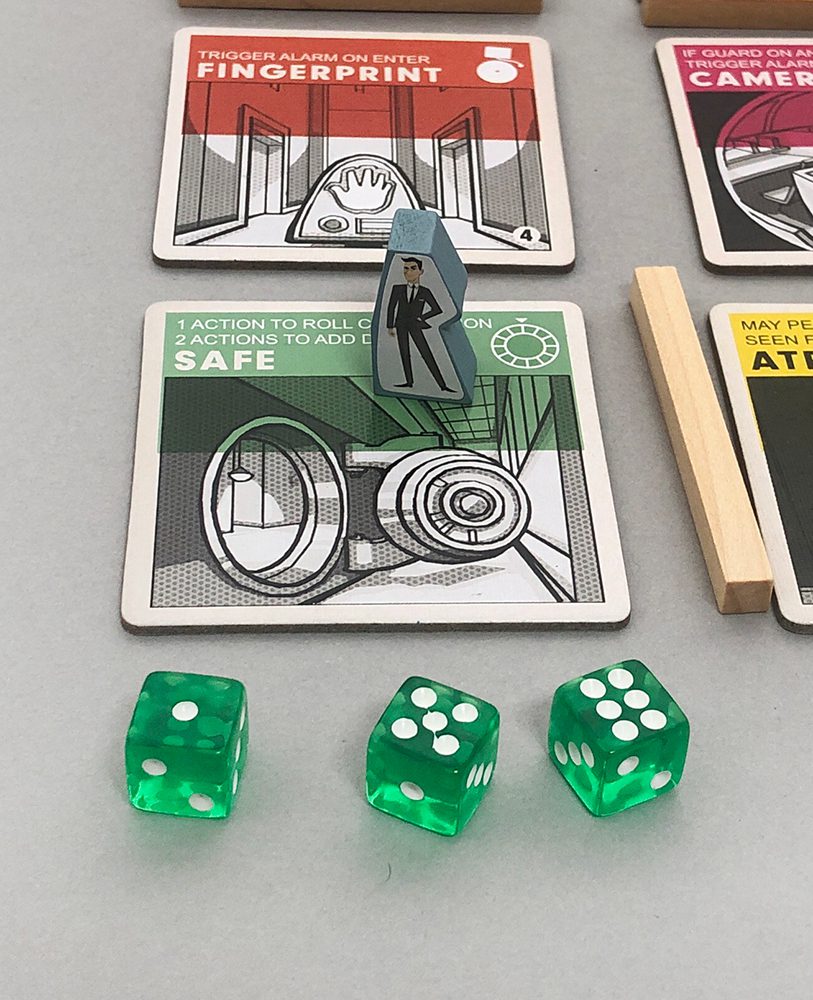
Once at the Safe a character can take two actions to add a die to the pool of dice to be rolled. Rolling takes an additional action. Each number in the combination only needs to be rolled once — a single roll of 3 covers all of the 3s that may be in the combination.
Once all of the numbers in the combination have been rolled, the player who rolled the last number gets to claim one Treasure and one Tool from the Safe.
Treasure
Ah, Treasure. Getting those riches is what this is all about, isn’t it? Grab the money and run, right?
The Treasures in Burgle Bros. are what you all came for but they each make your task that much harder as well.
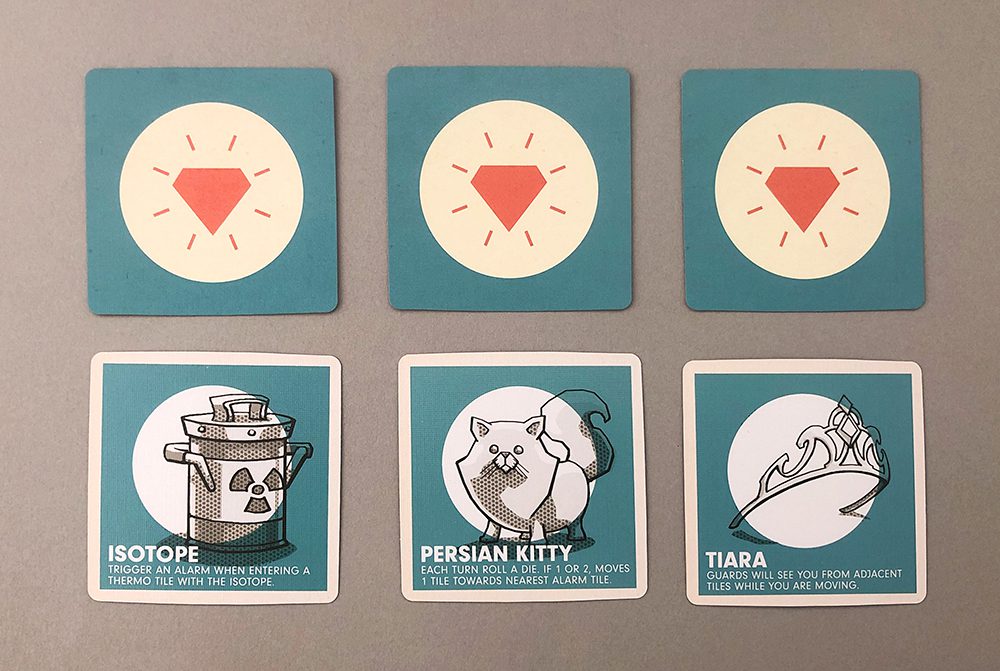
Most Treasures will set off alarms on Detector tiles. Other Treasures make you more visible to the Guards, while others limit your actions per turn or your ability to enter certain tiles.
Tools
Each Safe also provides you with a special, single-use Tool. Tools are very helpful things.
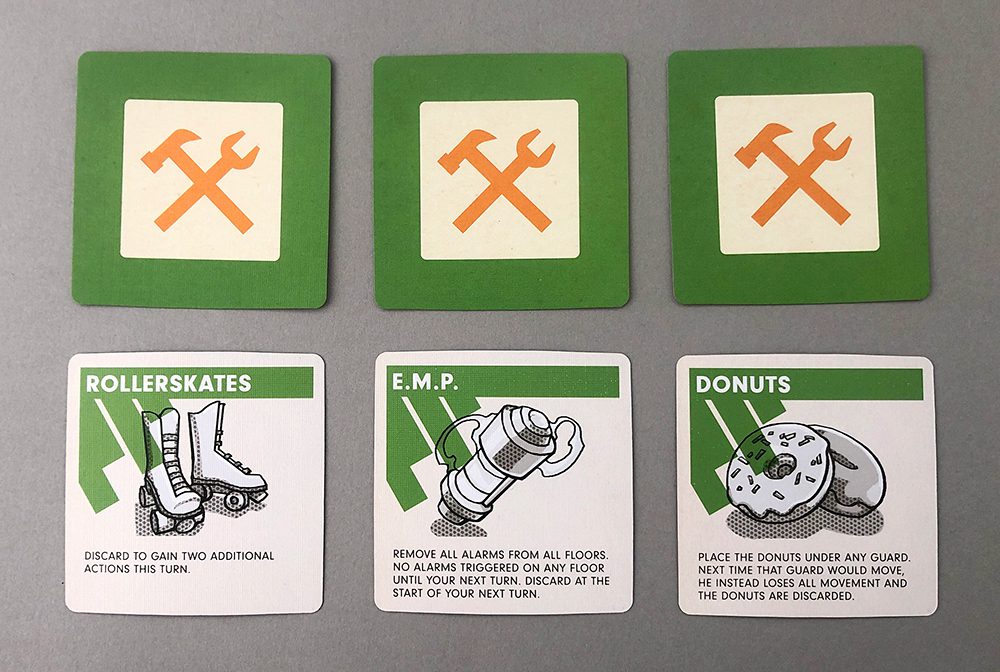
Tools can grant you additional actions on a turn, disable alarms, blow up the ceiling of a tile to create a new stairway to the next floor, and slow the Guard on that floor down.
Stairs
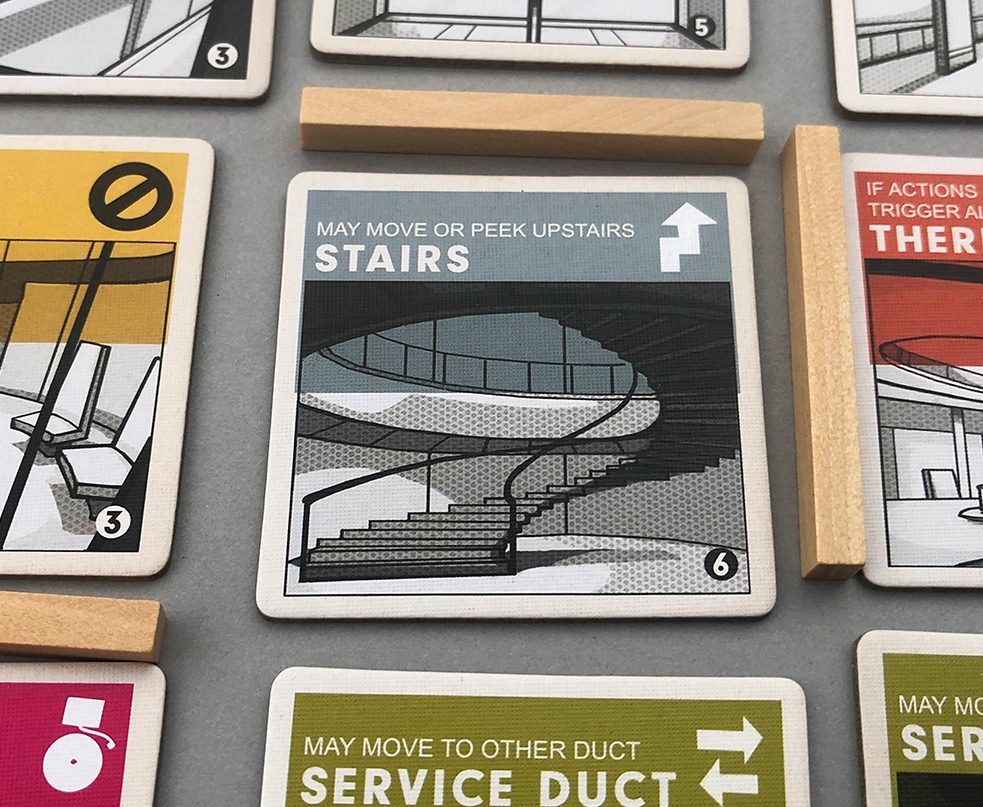
Once the Stairs are discovered on the first two floors of The Bank Job, players can choose to Peek at the room at the top of the stairs and take the Stairs to the floor above. Players do not need to crack the Safe on the first or second floor before going up to the next floor (but they must get the Treasure out of all three Safes in order to win the game). The third floor Stairs lead to the Helipad and are inaccessible until after you’ve unlocked the third floor Safe.
If a player moves up to another floor the Guard on that floor is activated. The top Guard card for that floor is turned over and a Guard is placed on the indicated tile. (If it’s the tile you’re on, you automatically lose a Stealth!) As long as you stay on that floor, at the end of each turn the Guard on that floor will move according to the location on the next Guard card.
When players are on separate floors, only the Guard on the player’s floor will move at the end of that player’s turn. (If a player is on the second floor, at the end of their turn only the Guard on the second floor will move. The Guards on the other floors will remain where they are until a player on their floor completes a turn.)
Crack all of the Safes, collect all the Treasures, and make it to the Helipad at the top of the third floor and you’ve won the game!
Taking a Moment to Appreciate the Burgle Bros. Box
Before moving on to my thoughts on Burgle Bros., I want to show you something.
I have written about the waste of space the game box for Splendor is. (It’s so bad that I 3D printed my own replacement box for the game.) It is only fitting, then, that designer Tim Fowers gets a major shout out for his wonderfully compact box.
You’ve seen all of the components laid out on a table. Now take a look at how they all pack away.

Standing up, that’s 8” tall by 5” deep by 4 ¼” wide. Everything — all 48 Room tiles, all 160+ cards, all of the character meeples, dice, and wall dividers — everything fits inside this wonderfully designed heist-looking box.
Thoughts on Burgle Bros.
One of my weekly gaming friends describes cooperative games as, “Bad things happen, then you die.” In the worst of cooperative games, this is certainly true. (I’m looking at you Ghost Stories. How does anyone ever win that game?)
In the best of cooperative games, players are never certain of their victory but always feel as if they still have a chance. A well-designed co-op game has been thoroughly play-tested to ensure that the game progressively gets more difficult but never overwhelms the players until the end. Players often carry on in the face of almost certain disaster, but typically never feel there is no hope of winning too early in the game.
This creates gaming sessions with lots of fun tension and makes for great memories. For instance, my favorite games of Pandemic have been those where we’ve won on the very last turn.
Burgle Bros. strikes this balance incredibly well. Knowing the Guard’s movements allows players to plan their moves as best they can, knowing that they cannot fully predict where the Guard will move before it is their turn again. (In a 3-player game, the Guard will move three times before it is your turn again, likely reaching the tile on the Guard card visible when you took your move, then moving on to another tile you couldn’t have planned for.) They’re a constant, moving threat that give the game its initial tension.
The characters each have their own special skills that make them valuable members of the team. After playing through all of them, there isn’t a weak one amongst them. (Even one we thought was weak turned out to be the reason we got so far in the game I just described.) As well, while there are more male characters than female, the skills of the female characters are on a par with their male counterparts. (Thankfully none are sexualized, which is a welcome change in board game artwork.)
Room tiles are certainly stacked against you, with only a few rooms that either don’t have negative consequences or delays associated with them. However, while these impediments are certainly annoying, they’re true to the theme and, as they’re uncovered, make for a constantly changing series of interesting decisions on where and how to proceed along the floorplan.
That the Treasures hidden away inside the Safes are often a mix of humor (the dog and cat, mentioned above) with negative effects (limiting movement, becoming visible from adjacent tiles, setting off alarms, etc.) means with every Safe cracked, the game instantly becomes harder for the player holding the goods.
There are three games detailed in the rules, each with its own layout. The Bank Job, the game I used in my examples above, is a three-floor scenario. The beginner’s scenario, The Office Job, is only two floors, while the expert scenario, The Fort Knox Job, is a two-floor, 5×5 layout with a matching empty space somewhere on the two floors.
If you’ve played for a while and want to experiment with different room divider floor plans, there is an online layout generator that will give you some very challenging layout options.
The only downside to Burgle Bros. is that it takes a lot of tablespace to set up. The 4×4 layout of tiles takes up about 12 ½” of space. That means The Office Job will take up close to 28” of space while The Bank Job will take close to 40”. That’s a lot of space.
While there are free 3D printer plans for scaffolding and floors for Burgle Bros., I’m not sure I’ll be adding it to my list of 3D printed gaming additions. Lighting for the bottom floors can be an issue and I can’t see how the third floor would be played without standing up to see the tiles.
I would be remiss if I didn’t take a moment to appreciate the fine job Ryan Goldsberry did on the game art. The characters are part Sixties, part modern-day hipster, giving the game a retro-modern feel with a distinct personality for each member of your safe-cracking party.
Tim Fower’s game works well on so many levels (pun intended) that it has quickly become one of my favorites to play, co-op or not. My weekly gaming group initially played Burgle Bros. to help me with this review. Since then we have continued to play — at their request — to win with all of the standard characters as well as working through different floor layouts. Every game has presented its own set of challenges, not to mention fun, memorable gaming experiences.











Add Comment